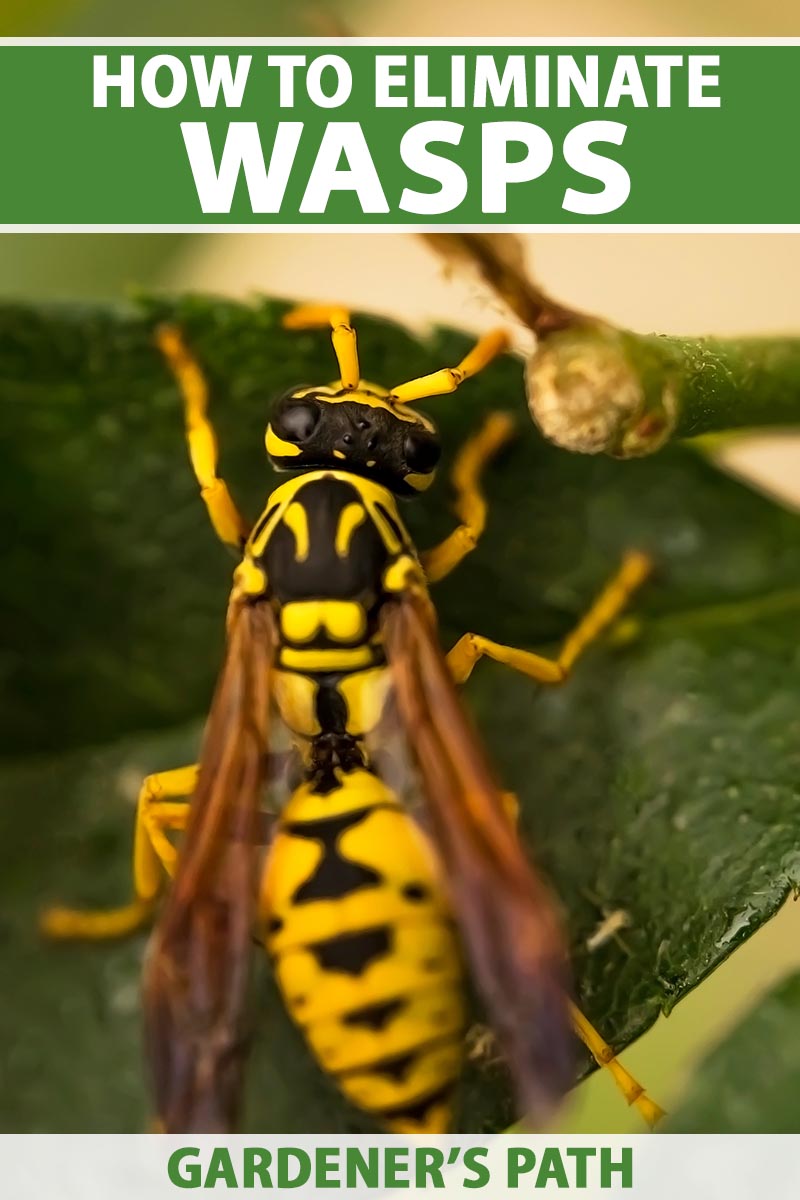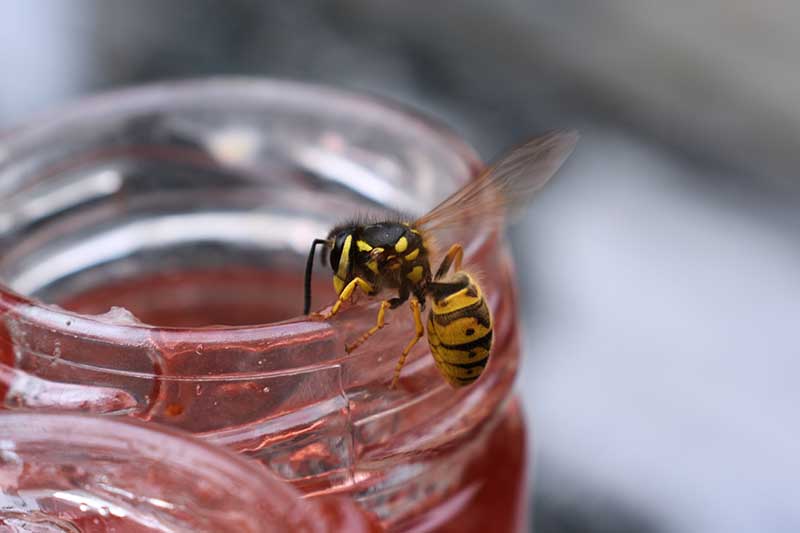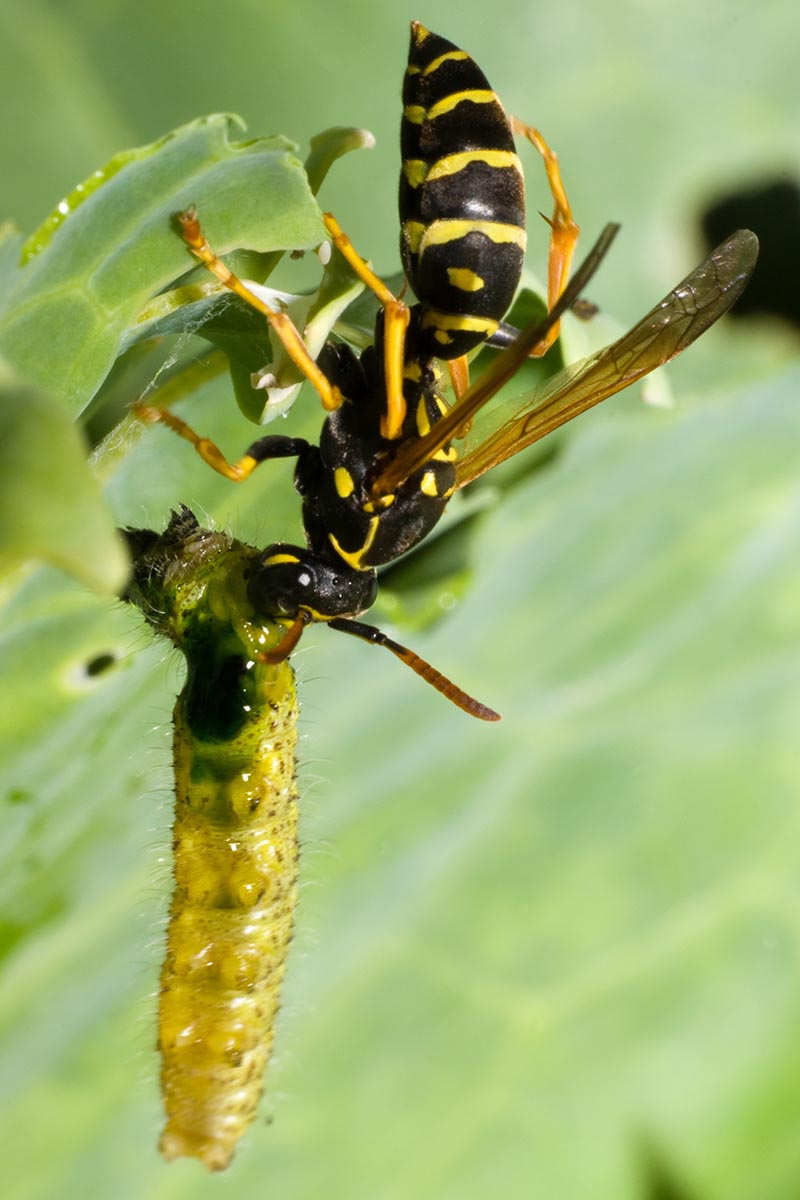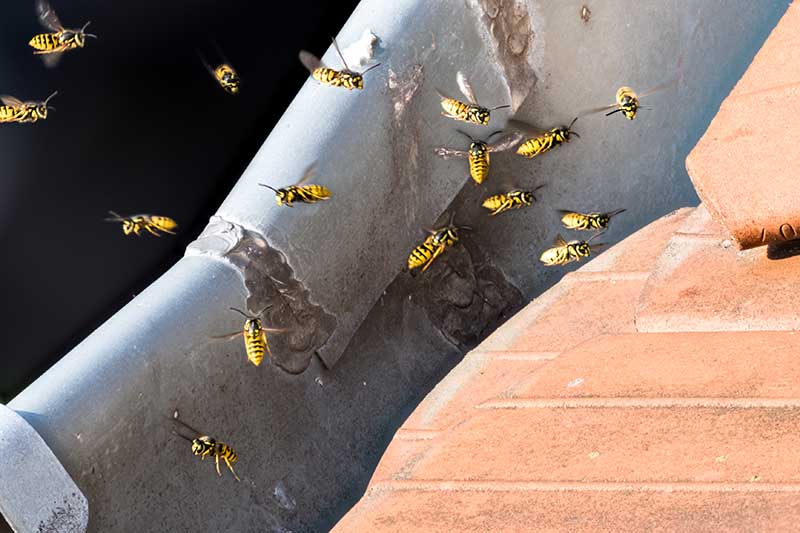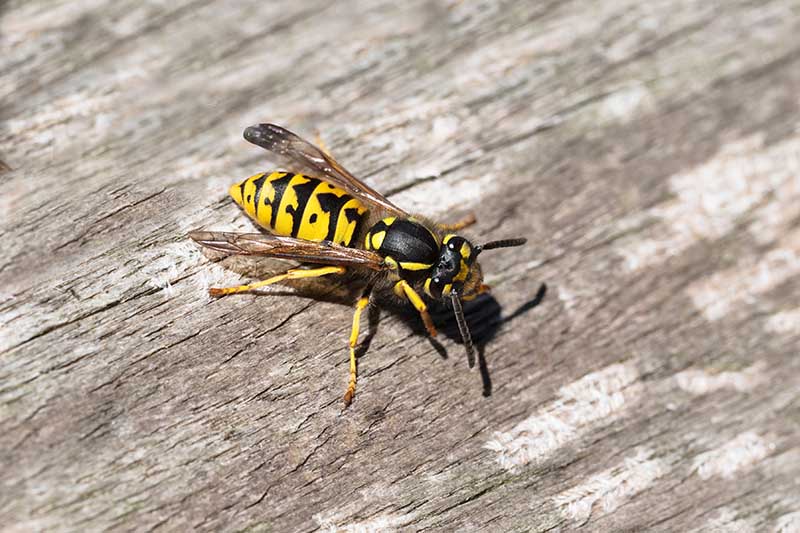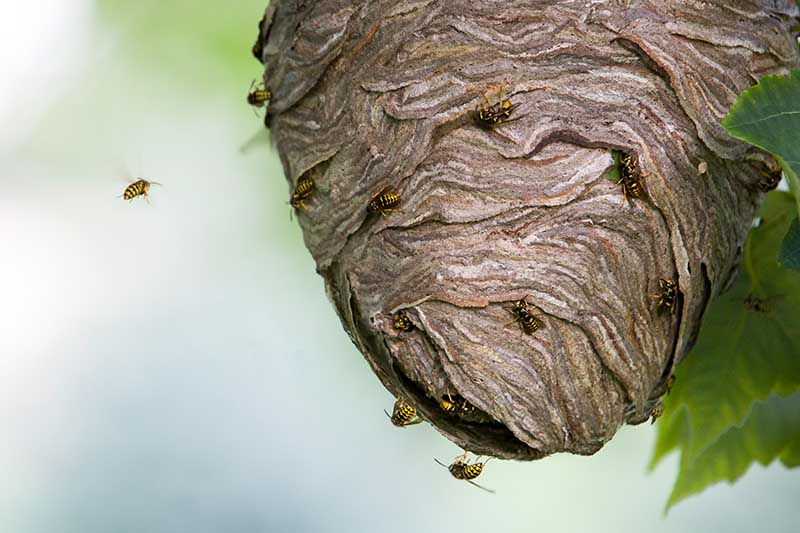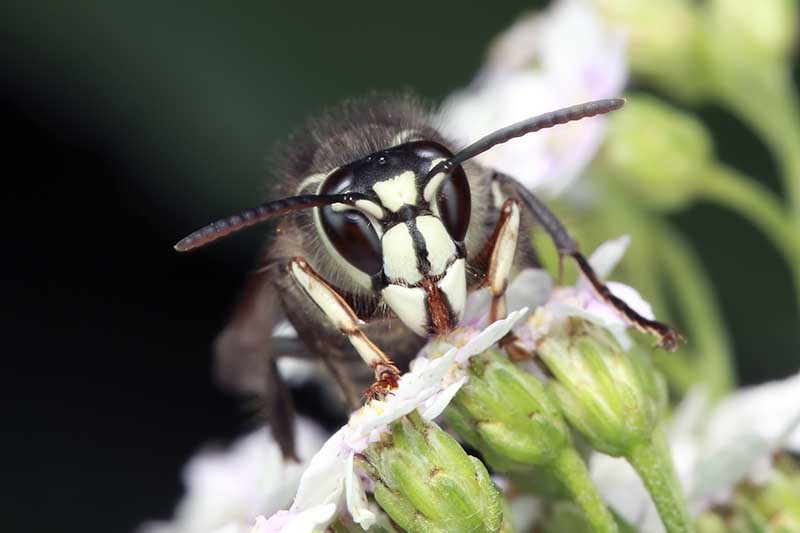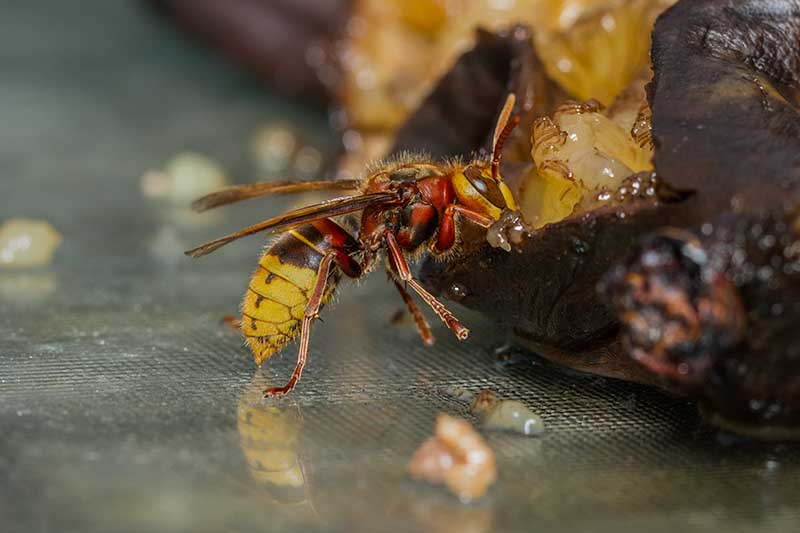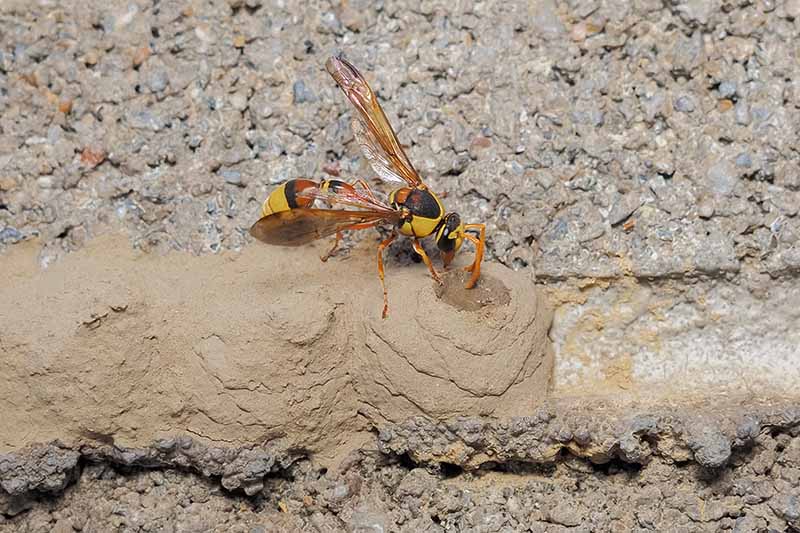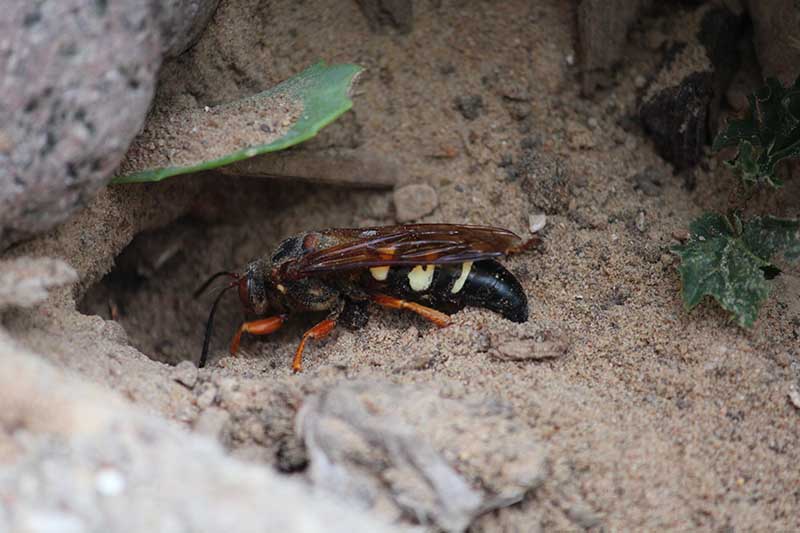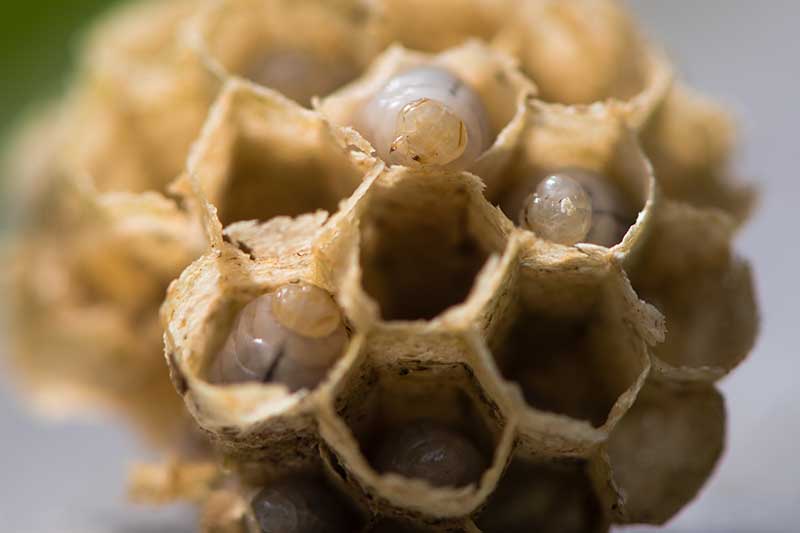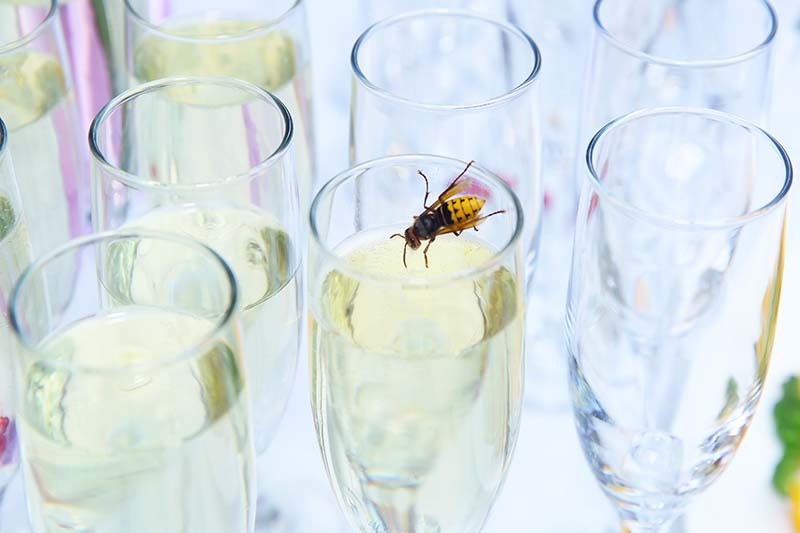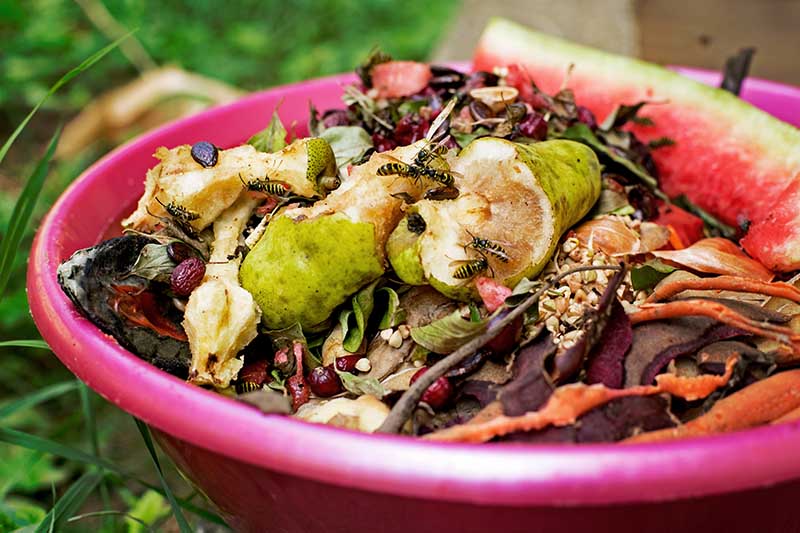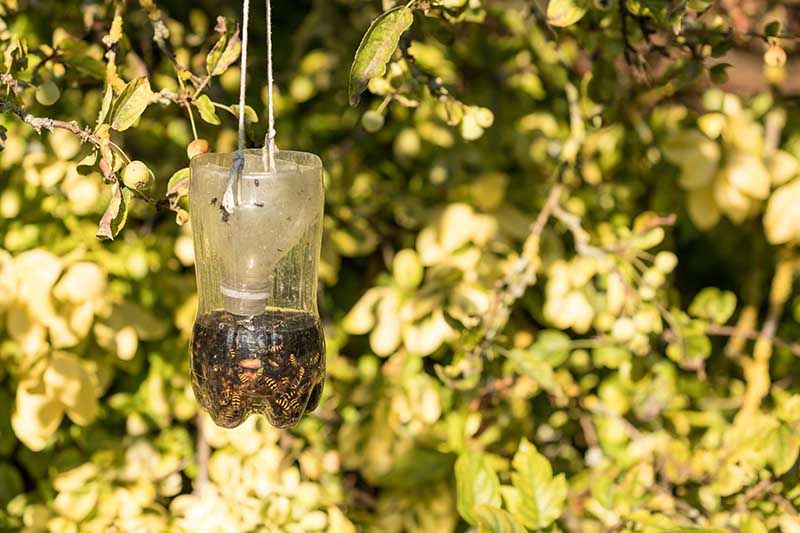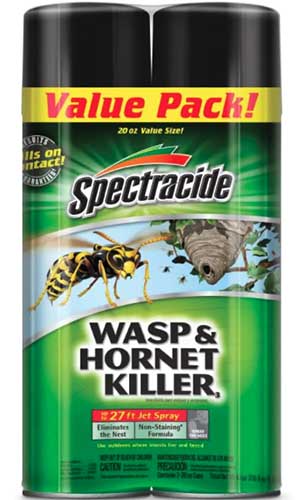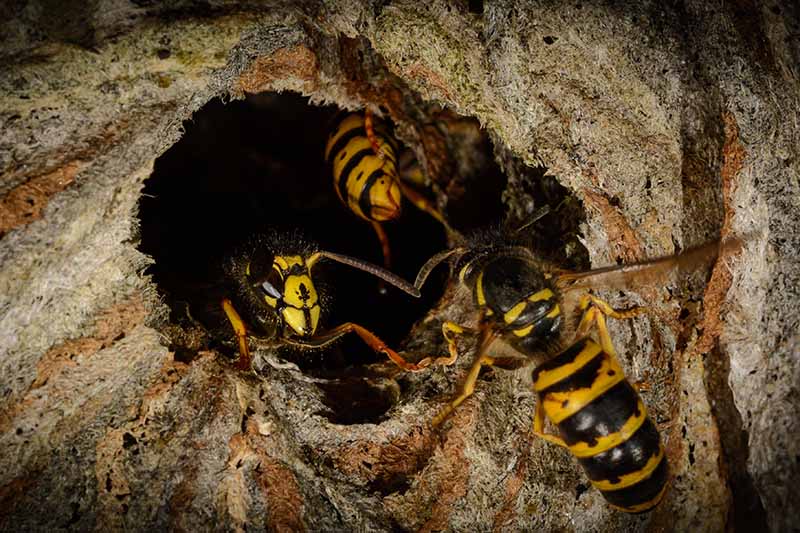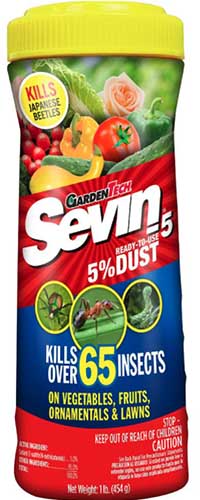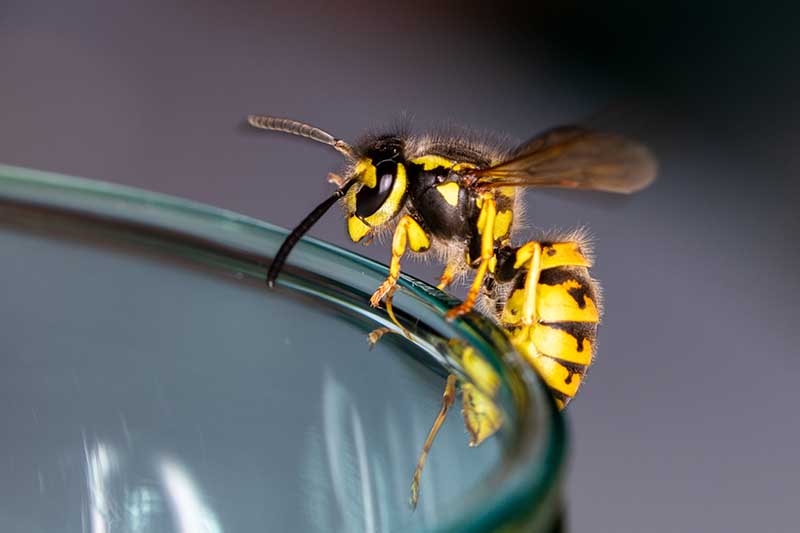They buzz around your head, they sit on your food and crawl into your drink, and they may sting. But they can also be valuable beneficial insects to have prowling around your garden – if they don’t make a home out of your house, or become a hazard for your family, that is. We link to vendors to help you find relevant products. If you buy from one of our links, we may earn a commission. Here’s what we’ll talk about:
What Are Wasps?
Wasps make up a large part of the order Hymenoptera, which also includes bees and ants. Many of these are harmless, but there are a few that give them a bad name. Most of the wasps with the unsavory reputation are social species from the Vespidae family, including yellow jackets, hornets, and paper wasps. From the tiniest parasitoid to the big cicada killer, these striped insects are generally good guys to have in the garden. They prey on pest insects and contribute to pollination. Social species, those that live and work together in a colony with one egg-laying queen and female workers, are rightfully protective of their home. They become a nuisance when they build their nests near areas filled with human activity and want to scavenge our food while we eat. While both males and females can show aggression, males are unable to sting. How do you tell the difference between bees and wasps? Unlike bees, which leave their stingers in the skin and die after stinging once, Vespidae species can sting multiple times. Continuing the comparison, bees only sting when absolutely necessary, most have hair, and they feed on pollen and nectar, while wasps are often boldly colored, shiny and mainly hairless, and are attracted to both sweets and savory foods including meat. Wasps forage, scavenge, and kill to acquire their food. If you’ve ever been harassed by flying insects at a picnic, it’s likely they were wasps, not bees. If you’ve ever been randomly stung without accidentally stepping on or provoking whatever got you, it was probably a wasp. Both will occasionally take up residence in building structures. And it is important to know which type of pest is living rent free before you reach for a can of spray. If you discover a honeybee nest, please call your local beekeeper or beekeeping club to find someone who can remove the colony. Not only does this save the bees, but it can save you from having to deal with a lot of damage and cleanup in the future. Honeybee colonies can have thousands of worker bees, larvae, and pupae, plus gallons of honey stored in beeswax. If you kill them, the high volume of rotting insects can stink up your home. Plus, if there are no bees regulating the temperature inside the hive, the wax can melt during the summer, allowing pools of honey to drip and flow through walls and ceilings. Before we get into how to identify them, though, do not attempt to control them yourself if you are allergic. There are pest management professionals you can call to do the job for you, whether you are allergic, fearful, or simply don’t have the time or resources to deal with a nest. If you do get stung, either while minding your own business or attempting to eliminate them, everyone’s body reacts differently. The area might swell and become painful, itchy, and red. Apply an icepack on painful and swollen areas, and if it is safe for you to use, try a topical or oral antihistamine to help alleviate symptoms. If you experience nausea, widespread itching, hives, difficulty breathing or swallowing, dizziness, or an increased heart rate, or your face, mouth, or throat start to swell, seek emergency medical attention immediately.
Identification
The species in the Vespula genus are commonly known as yellow jackets. About three-eighths to five-eighths of an inch in length, they have hard shiny bodies with black and bright yellow markings. The stripes aren’t straight lines, but are made up of spots, diamonds, and triangles. Yellow jackets build their nests out of wood that is mixed with saliva and chewed into a papery pulp. They construct rounded, stacked combs which they surround with several layers of pulp. You can find their nests above or below ground, in old rodent holes, logs, and in buildings. Anywhere from a few hundred to several thousand individuals can occupy one nest. Colonies die off in the fall, and the nests will not be reused. Paper wasps (Polistes spp.) have slender bodies, and long legs that dangle underneath them as they fly. One inch long, they are often brown or rust colored with yellow markings. However, a common species known as the European paper wasp looks more like a yellow jacket, with black and yellow markings. Polistes species prefer to build their nests near orchards and vineyards. They build one comb of cells out of papery pulp, but they don’t surround it with paper like yellow jackets do. Instead, they hang it from any horizontal surface available to them in an open umbrella shape, which is why they are sometimes called umbrella wasps. Their nests are small, usually only housing about a dozen to a maximum of one hundred individuals. They also don’t reuse them. Hornets come in a variety of colors, from black and white to black, yellow, and bronze. Their stings are painful. The baldfaced variety, Dolichovespula maculata, is a common and aggressive type. It has a stout, three-quarter-inch-long body with black and white markings. Baldfaced hornet nests are large, gray, papery, and football-shaped. They hang from trees, bushes, or buildings, and are often found high up. European hornets, Vespa crabro, are large one-and-a-half-inch-long insects with brown and yellow markings. They like to build layered paper enclosed nests in hollow trees, and cavities in other structures such as barns. Solitary wasp species will make their homes in gardens, and near or on your house as well, but are rarely as much of a pest as the social types are. Their nests can be unsightly and seeing them fly around can be unnerving for some, but in general, they are beneficial garden predators. Mud daubers, which belong to the Sphecidae or Crabronidae families, love to build their clay and mud homes on eaves, porch roofs, and shutters, so they are common home and garden insects. They are solitary and not aggressive. In general, they have long, thin bodies and they come in a variety of shapes and colors. Cicada killers, Sphecius speciosus, are another type of solitary wasps commonly found in the garden. At over an inch long, they are large, so they are often confused with murder hornets. Asian giant hornets, nicknamed murder hornets because of the potency of their stings, are the world’s largest hornet species. Since appearing in North America for the first time in the fall of 2019, they’ve been a popular topic in the media. Be assured that, as of the time of this writing, murder hornets (Vespa mandarinia) have only been found in a small area of Washington State, and are not believed to be established in North America. The large cicada killer males are moderately aggressive and can be intimidating, but keep in mind that the males, like all male wasps, can’t sting. Cicada killers have smoky brown wings, and their bodies have black and yellow markings. Cicada killers are ground nesters that dig their homes in bare slopes. Their entrance holes are half an inch in diameter, and you’ll often see a pile of excavated soil heaped underneath.
Biology and Life Cycle
The wasp life cycle has four stages: egg, larva, pupa, and adult. The eggs are laid individually into the prepared cells, fed as larvae with bits of protein such as chewed insects, and sealed up to pupate. Social colonies only survive for one year, with all individuals besides the newly mated queens dying off when freezing temperatures hit. Solitary species such as mud daubers and cicada killers overwinter as solitary resting larvae. In the spring, yellow jacket and paper wasp queens produced the previous fall emerge from their overwintering sites. Yellow jackets overwinter solo, but Polistes queens can spend the winter in groups. After emerging, the queens search for a good site and start building nests, laying eggs, and foraging for food to feed the sterile female worker larvae that emerge. After pupating and emerging as adults, these workers take over the building, foraging, and feeding duties while the queen continues to lay eggs. Sometimes, paper wasp queen groups will start a nest together. One queen becomes dominant and begins laying while the others function as workers. If the dominant queen dies or is killed, another will take over egg laying duties. Populations peak in August, and this is generally when you’ll start noticing large numbers of individuals flying around, scavenging, and making nuisances of themselves at picnics. In the late summer, males are produced as well as fertile females, which will become the next year’s queens. The queen stops laying eggs. The fertile females mate, and find a place to overwinter under tree bark, in rotten logs, or under siding. They will start the cycle over again in the spring. The colony declines and is killed when temperatures dip below the mid 20s.
Organic Control Methods
It is up to you to decide whether to destroy a nest or not. You might decide to leave small nests alone. Or, you might decide to only eliminate those near areas where human activity takes place to keep your family safe, and to try to reduce the numbers of scavengers annoying your visitors during a barbecue. There are a variety of predators in nature that will prey on these insects, including birds, bears, skunks, raccoons, reptiles, amphibians, spiders, praying mantids, and other wasp species. However, if you have a big colony nesting in your home or near where your children play, nature’s predators are not going to cut it. Most of the non-chemical control methods available are useful when dealing with individual scavengers being a nuisance. These striped insects forage for a quarter mile to a mile from their home, so even if you don’t have a nest in your backyard, your neighbor’s wasps could come visiting when you are eating al fresco. The best way to deal with one buzzing around your head is to keep calm and ignore it. Waving your hands and trying to swat it may just provoke it. Avoid wearing fruity or sweet-scented perfumes, which will attract them to your body when you plan to spend time outdoors. When it comes to scavengers, sanitation is important. In the summer they are attracted to a variety of sweets and proteins, so yards with spilled food and open garbage or recycling containers are irresistible. Try serving food only once you and your guests are ready to eat, and clean up soon afterwards. Always check your drink glass and bite of food before putting it to your mouth! You can kill individuals or paper wasp nests with a spray of soapy water. Keep an eye out for the large queens scouting for good nesting areas in the spring. If you notice a queen starting to build, remove the nest foundations when she’s not present to discourage her from building in that spot. You can discourage cicada killers from nesting in certain areas by applying a thick layer of wood chips or planting thick vegetation on bare spots in your garden or lawn. Caulk and seal cracks on the outside of your home and buildings. Traps use lures of heptyl butyrate, proteins such as meat or fish, or a combination of both as bait. Bees aren’t attracted to these types of baits. The wasps either enter the traps and can’t find their way out or are drowned in water. Traps that use meat need to be cleaned out and the bait must be replaced regularly for them to stay effective. You can either add string and hang it low in a tree or set it on the ground. The insects crawl down to the bait, won’t be able to find their way out, and drown. Rescue WHY Trap You can find this trap available for purchase at Arbico Organics. Alternatively, construct your own trap by cutting off the fluted top of a two-liter pop bottle, adding several inches of water and bait to the bottom, and inserting the cut top in upside down. Set traps out in the spring to try to catch the queens, or in the fall to catch scavenging individuals. Traps can catch hundreds of individuals, which may or may not help to reduce the number of scavengers visiting your yard. If nests are established in your building or garden, do not attempt to knock them down or remove them before you are certain they are dead. The only way to effectively kill them all in order to facilitate safe removal is to use chemicals. You can do this yourself, or consider enlisting professional help, especially if the nest is in a wall cavity or attic.
Chemical Pesticide Control Options
When using a chemical to kill these pests, it is best to apply the product early in the morning or late in the evening, when they are less active. Also, consider wearing long sleeves, pants, and closed shoes, gloves, and a netted hat if you have one. For paper wasps, aim the stream directly at the exposed comb. The type of chemical control method you choose to use will depend on the species and the nest’s location. If it is an outdoor aerial nest, choose an aerosol product labeled for wasps, hornets, and similar insects, such as Spectracide Wasp and Hornet Killer Spray, available at Home Depot. Spectracide Wasp and Hornet Killer Spray For yellow jacket and hornet nests, spray a jet of the product into the entrance hole, taking care to stand as far back as possible. Pouring liquid pesticide into the hole is not recommended, nor is it as effective as using a dust. Liquid products might soak into the ground and disappear without reaching the nest. If it is a ground nest, use an insecticide dust such as Sevin 5 Ready to Use Garden Insect Killer Dust, available at Home Depot. Sevin Garden Insect Killer Dust In the evening, dump the dust into and around the entrance hole. Do not seal the hole immediately but wait a couple of days and watch for dwindling activity. Once the colony is dead, go ahead and fill the hole. Powdered or dust products are much more effective for use on ground nests than liquid, since it sticks to the bodies of the active adults and is carried into the nest to kill the entire colony. If they’ve built a nest inside walls or structure cavities, dusts are also more effective than sprays. Make sure the product you choose is labelled for indoor use. If you can’t find one that is labelled for use inside structures, contact a professional. Do not seal the entrance of a structural nest before you are certain the colony inside is dead. Any living wasps will try to find an alternate exit, and can chew through walls and ceilings into your house. Eliminating the nests may not be necessary if they are out of the way, but if they build their nests near where your family and guests gather, you may decide to destroy them. Now that you’ve read this article, you know exactly what your options are, and how to go about dealing with these pests in and around your home and garden! Have wasps ever built nests on your property? Let us know how you dealt with them in the comments below! Keep reading about Hymenoptera insects in the garden in these guides next:
Ground and Wood Nesting Bees: Learn to Identify Common Backyard SpeciesYellowjacket Identification, Facts and Control Measures
